Etruscan Civilization
 From Nwe
From Nwe The Etruscan civilization is the name given today to the culture and way of life of a people of ancient Italy whom ancient Romans called Etrusci or Tusci, ancient Greeks called Tyrrhenoi or Tyrrsenoi and who called themselves Rasenna, syncopated to Rasna or Raśna. As distinguished by its own language, the civilization endured from an unknown prehistoric time prior to the foundation of Rome until its complete assimilation to Ancient Rome in the Roman Republic; numerous vestiges of Etruscan culture do survive the Roman conquest. At its maximum extent during the foundation period of Rome and the Roman kingdom, it flourished in three confederacies: of Etruria, of the Po valley and Latium and of Campania. Rome was sited in Etruscan territory. There is considerable evidence that early Rome was dominated by Etruscans until the Romans sacked Veii in 396 B.C.E.
Culture that is identifiably and certainly Etruscan developed in Italy after about 800 B.C.E. approximately over the range of the preceding Iron Age Villanovan culture. The latter gave way in the seventh century to an increasingly orientalizing culture that was influenced by Greek traders and Greek neighbors in Magna Graecia, the Hellenic civilization of southern Italy. Within one hundred years they had developed into three confederacies of 36 cities. Etruscan culture reached a very high material level by the time it was absorbed by Rome.
The high cultural achievements of Rome may have been largely derivative, and the Etruscan heritage was a vital ingredient. Thus it can be said that the Etruscan legacy made a major contribution to the culture (Rome) that did much to unify Europe and the Mediterranean Basin, and whose legal and administrative systems are still the basis of many European states. Yet the Etruscan contribution has not always been acknowledged, as due in no small part to the Romans, who in their own understanding of their origins tended to downplay their indebtedness to Etruria.
Language
The Etruscans are generally believed to have spoken a non-Indo-European language. After generations of speculation, secure knowledge of the Etruscan language only began with the discovery of the bilingual Phoenician-Etruscan Pyrgi Tablets found at the port of Caere in 1964, and this knowledge is still incomplete.
Origins
Herodotus (1.94) records the legend that they came from Lydia:
The customs of the Lydians are like those of the Greeks, except that they make prostitutes of their female children. They were the first men whom we know who coined and used gold and silver currency; and they were the first to sell by retail. And, according to what they themselves say, the games now in use among them and the Greeks were invented by the Lydians: these, they say, were invented among them at the time when they colonized Tyrrhenia. This is their story: [...] their king divided the people into two groups, and made them draw lots, so that the one group should remain and the other leave the country; he himself was to be the head of those who drew the lot to remain there, and his son, whose name was Tyrrhenus, of those who departed. [...] they came to the Ombrici, where they founded cities and have lived ever since. They no longer called themselves Lydians, but Tyrrhenians, after the name of the king's son who had led them there.
Contrarily, Dionysius of Halicarnassus (c. 100 B.C.E.) pronounced the Etruscans indigenous to Italy, calling themselves Rasenna and being part of an ancient nation "which does not resemble any other people in their language or in their way of life, or customs."
Some researchers have proposed that the non-Greek inscriptions found on the island of Lemnos, appearing to be related to the Etruscan language and dated to the sixth century B.C.E., support Herodotus' hypothesis. However, recent research, referencing burial rituals, shows that there was no break in practices from the earlier settlements of the Villanovan culture to the Etruscans, indicating that they were likely indigenous, at least as far as the Romans were concerned. The Romans termed indigeni all peoples they knew to be more ancient than they.
The term "Etruscans" should not imply that the culture was confined to Italy. There were too many to all have come from Lemnos, and there is no evidence of them in Lydia. They were, however, a seafaring people. Thousands of Etruscan inscriptions from all over the Mediterranean, especially the eastern Mediterranean, testify their presence. The end of their power dates from the time that the Romans began systematically to take over their seaports.
A possible Etruscan sea people
An Egyptian inscription at Deir al-Madinah records a victory of Ramesses III over Sea Peoples, including some named Tursha (spelled [twrš3] in Egyptian script). These are probably the same as the earlier Teresh (found written as [trš.w]) of the Merneptah Stele, commemorating Merneptah’s victory in a Libyan campaign at about 1220 B.C.E.. This may be too early for the Trojan War. Some have connected the name to the Hittite city Taruisas, Troy. Also the name is connected to the biblical patriarch Tirash, the ancestor of the Thracians and Etruscans.
The seafaring Etruscans may simply have sought brides from among their client or host populations, accounting for the mitochondrial DNA. At the other end of the spectrum of possibilities, perhaps some Trojans emigrated to Etruria, accounting for the different names. We have no evidence as to what language they spoke. They could have assimilated to Etruscan culture, just as the Etruscans assimilated to the Romans. The latter assimilation was thorough. The population of modern Tuscany is the closest of the moderns to the Etruscans, but that is not very close. The moderns do not evidence the higher degree of kinship to Anatolia or north Africa, and they are more related to the Basques than the ancients.
Archaeological possibilities
A final thread illuminated by the genetic evidence is the possible central European origin of the Villanovan. It appears to be an offshoot of the Urnfield. Some have hypothesized that the Villanovan represents immigrant Celts or Old Europeans (lumped under the Greek term “Pelasgian.”). Perhaps the Etruscans entered Italy over the Alps.
Genetically, the ancient Etruscans have no closer affinities to the modern people of east Europe than do modern Italics. Moreover, the Urnfield never included only the Celts, and the Villanovan did not include only the Etruscans. It spread to Italics as well. More than likely, the Villanovan only represents a central European cultural influence and not a transfer of population.
If the Etruscans moved to Italy from Europe, they are most likely to have done so much earlier, and there is some evidence of that. The Rinaldone culture of central Italy and its twin, the Remedello culture of the Po Valley, appear to represent imports from the Fyn and Horgen cultures of the Swiss lakes region, who were being pushed ultimately by Indo-European pressure originating in the north Pontic area. The two pockets are remarkably coincidental, but the dates of those cultures are in the 3500-3000 B.C.E. window. Over the span of a few thousand years, it is impossible to say what the language might have been.
Genetics
In an effort to resolve the contradictions, a team of geneticists from different universities in Italy and Spain undertook the first genetic studies of the ancient Etruscans, based on mitochondrial DNA from 80 bone samples taken from tombs dating from the 7th century to the 3rd century B.C.E. in Etruria. The results are enlightening but also contradictory.
This initial genetic study of the Etruscans finds that they were more related to each other than to the population of modern Italy; i.e., they qualify as a partially distinct genetic pool, or "people." Moreover, this pool contained between about 150,000 to 200,000 women. Dividing these numbers by the 36 cities in the three Etruscan leagues obtains an average of between 4167 and 6944 women per community. Selecting an arbitrary family size of four gives a most approximate Etruscan population of 600,000 to 800,000 persons in about 36 communities of an average between 16,668 and 27,776 persons each. These populations are sufficiently dense and sufficiently urban to have accomplished everything the Etruscans were supposed to have accomplished. While this study gives an insight into the genetic composition of the Etruscans, and excludes a mass migration from Anatolia, it cannot resolve the linguistic controversy: An invasion of an elite imposing itself over autochthonous subjects often leads to linguistic changes without leaving genetic traces.
It's also shown that there is a link between Etruscans and Turks.[1]
Etruscan society
Kinship
The cemeteries of the Etruscans give us considerable information about their society. They were a monogamous society that emphasized pairing. The word for married couple was tusurthir. The lids of large numbers of sarcophagi are adorned with sculpted couples, smiling, in the prime of life (even if the remains were of persons advanced in age), reclining next to each other or with arms around each other. The bond was obviously a close one by social preference.
The names of persons are generally binomial: Vethur Hathisna, Avile Repesuna, Fasti Aneina. The second name is typically a patronymic, but it is often made into a gentilical name with a -na suffix, normally used for adjectives. Presumably, clans are a later development of a richer landed society. Dedications to Selvans (Sylvanus), the god of boundaries, are common. The Etruscans at their height used lautun, syncopated to lautn, to mean gens.
Kinship is defined with relation to the ego, or "I." I then may state whatever "I" am or you are to me. Females could state that they were the daughter of a father, sec or sech, and the wife of a husband, puia. Conversely, a man was never described as a husband of a woman. Etruscan society therefore was patrilineal and probably patriarchal.
Kinship among the Etruscans was vertical, or generational. They kept track of six generations. In addition to the mi (“I”) an individual recognized a clan (“son”) or a sec (“daughter”), a neftś (“grandson”), and a prumaths (“great-grandson”). Every self had an apa and ati (“father” and “mother”) and relatives older than they.
A division of relatives as maternal or paternal seems to have existed: the apa nachna and the ati nachna, the grandfather’s and grandmother’s relatives. On the level of the self, the lack of any words for aunt, uncle or cousins is notable. Very likely, apa was a generational word: it meant father or any of father’s male relatives. Similarly, ati would have meant any female relative of mother’s age or generation. Ruva (“brother”) is recognized, but no sister. It's possible, though hard to determine, that ruva had a broader meaning of "any related male of the self’s generation."
This horizontal telescoping of relatives applies indirectly to the self as well. The telals are the grand offspring, either male or female, of the grandmother, and the papals of the grandfather. It's difficult to determine whether neftś means "grandson" or "nephew" although there could be cross-cultural contamination here with Latin nepōs (< IE *nepōts) which derives from a kinship system of the Omaha type. In the Omaha type, the same word is used for both nephew and grandson but this kinship type does not typically exhibit terminology used for "kin of a particular generation" as suspected in Etruscan kinship terms.
The Etruscans were careful also to distinguish status within the family. There was a step-daughter and step-son, sech fanthana and clan thuncultha (although this may in fact mean "first son" based on the root thun- "one"), as well as a step-mother, ativu (literally "little mother"), an adopted son, clanti, and the universal mother-in-law, netei. Other terms were not as high or democratic in status. The system was like that of the Roman. The etera were slaves, or more precisely, foreign slaves. When they had been freed they were lautni (male) or lautnitha (female), freed men or women, who were closely connected to the family and were clients of it in return for service and respect.
Of the several formal kinship classifications, the Etruscan is most like the Hawaiian, which distinguishes sex and generation, but otherwise lumps persons in those classes together. The lack of a sister does not fit; however, the Etruscan dictionary is still in progress. Perhaps one will turn up.
Government
The historical Etruscans had achieved a state system of society, with remnants of the chiefdom and tribal forms. In this they were ahead of the surrounding Ancient Italic peoples, who still had chiefs and tribes. Rome was in a sense the first Italic state, but it began as an Etruscan one.
The Etruscan state government was essentially a theocracy. The government was viewed as being a central authority, over all tribal and clan organizations. It retained the power of life and death; in fact, the gorgon, an ancient symbol of that power, appears as a motif in Etruscan decoration. The adherents to this state power were united by a common religion.
The political unit of Etruscan society was the city-state, which was probably the referent of methlum, (“district”). Etruscan texts name quite a number of magistrates, without much of a hint as to their function: the camthi, the parnich, the purth, the tamera, the macstrev, and so on. The people were the mech. The chief ruler of a methlum was perhaps a zilach.
All the city-states of the Etruscans were gathered into confederacies, or “leagues.” The sources tell us there were three. A league for unknown reasons, likely religious, had to include 12 city-states. The word for league was also mech. Once a year the states met at a fanu, or sacred place (Latin fanum) to discuss military and political affairs, and also to choose a lucumo (ruler), who held the office for one year. What he did is described by the infinitive, lucair (to rule). The Etrurian confederacy met at the fanum Voltumnae, the "shrine of Voltumna." Their league was called the “duodecim populi Etruriae” or the “twelve peoples of Eturia.”
The relationship between Rome and the Etruscans was not one of an outsider conquering a foreign people. The Etruscans considered Rome as one of their cities, perhaps originally in the Latian/Campanian league. It is entirely possible that the Tarquins appealed to Lars Porsena of Clusium (sixth century king), even though he was pro-republican, because he was lucumo of the Etrurian mech for that year. He would have been obliged to help the Tarquins whether he liked it or not. The kings of Rome at some point may also have been lucumo. The gens name, Lucius, is probably derived from lucair.
The Romans attacked and annexed individual cities between 510 and 29 B.C.E. This apparent disunity of the Etruscans was probably regarded as internal dissent by the Etruscans themselves. For example, after the sack of Rome by the Gauls, the Romans debated whether to move the city en masse to Veii, which they could not even have considered if Veii was thought to be a foreign people. Eventually Rome created treaties individually with the Etruscan states, rather than the whole. But by that time the league had fallen into disuse, due to the permanent hegemony of Rome and increasing assimilation of Etruscan civilization to it, which was a natural outcome, as Roman civilization was to a large degree Etruscan.
Religion
The Etruscan system of belief was an immanent polytheism; that is, all visible phenomena were considered to be a manifestation of divine power and that power was subdivided into deities that acted continually on the world of man and could be dissuaded or persuaded in favor of human affairs. Three layers are evident in the extensive Etruscan art motifs. One appears to be divinities of an indigenous nature: Catha and Usil, the sun, Tivr, the moon, Selvan, a civil god, Turan, the goddess of love, Laran, the god of war, Leinth, the goddess of death, Maris, Thalna, Turms and the ever-popular Fufluns, whose name is related in some unknown way to the city of Populonia and the populus Romanus. Perhaps he was the god of the people.
Ruling over this panoply of lesser deities were higher ones that seem to reflect the Indo-European system: Tin or Tinia, the sky, Uni his wife (Juno), and Cel, the earth goddess. In addition the Greek gods were taken into the Etruscan system: Aritimi (Artemis), Menrva (Minerva), Pacha (Bacchus). The Greek heroes taken from Homer also appear extensively in art motifs.
The Etruscans believed in intimate contact with divinity. They did nothing without proper consultation with the gods and signs from them. These practices, which we would view as superstition, were taken over in total by the Romans. A god was called an ais (later eis) which in the plural is aisar. Where they were was a fanu or luth, a sacred place, such as a favi, a grave or temple. There you needed to make a fler (plural flerchva) "offering."
Around the mun or muni, the tombs, were the man or mani (Latin Manes), the souls of the ancestors. A deceased person travels to the underworld called Aita "Hades" and thus may be referred to as a hinthial (literally "(one who is) underneath"). A special magistrate, the cechase, looked after the cecha, or rath, sacred things. Every man, however, had his religious responsibilities, which were expressed in an alumnathe or slecaches, a sacred society. No public event was conducted without the netsvis, the haruspex, or his female equivalent, the nethsra. They read the bumps on the liver of a properly sacrificed sheep. We have a model of a liver made of bronze, whose religious significance is still a matter of heated debate, marked into sections that perhaps are meant to explain what the bump in that region should mean. Divination through haruspices is a tradition originating from the Fertile Crescent.
Like the Egyptians, the Etruscans believed in eternal life, but prosperity there was linked to funereal prosperity here. The tombs in many cases were better than many houses, with spacious chambers, wall frescoes and grave furniture. Most Etruscan tombs have been plundered. In the tomb, especially on the sarcophagus, was a representation of the dead person in his or her prime, probably as they wanted to be in the hereafter. Some of the statuary is the finest and most realistic of any. We have no problem visualizing the appearance of the Etruscans. They wanted us to see them smiling and intimate with their kith and kin around them, as we do.
Etruscan heritage at Rome
Those who subscribe to an Ancient Italic peoples foundation of Rome, followed by an Etruscan invasion, typically speak of an Etruscan “influence” on Roman culture; that is, cultural objects that were adopted at Rome from neighboring Etruria. The prevalent view today is that Rome was founded by Etruscans and merged with Italics later. In that case Etruscan cultural objects are not influences but are a heritage.
The main criterion for deciding whether an object originated at Rome and traveled by influence to the Etruscans, or descended to the Romans from the Etruscans, is date. Many if not most of the Etruscan cities were older than Rome. If a given feature was found there first, it cannot have originated at Rome. A second criterion is the opinion of the ancient sources. They tell us outright that certain institutions and customs came from the Etruscans.
The Question of the founding population
Due to the fact that Rome was destroyed by the Gauls, losing most of its inscriptional evidence about its early history—according to Livy (59 B.C.E. - 17 C.E.)—most of that history is legendary. Archaeology confirms a widespread level of destruction by fire dated to that time. Legend; namely, the story of the rape of the Sabine women, says outright that the Italic Sabines were brought into the state.
Later history relates that the Etruscans lived in the Tuscus vicus (the “Etruscan quarter”), and that there was an Etruscan line of kings (albeit ones descended from Demaratus the Corinthian) as opposed to the non-Etruscan line. Demaratus was father of Lucius Tarquinius Priscus, the fifth king of Rome and grandfather of Lucius Tarquinius Superbus, the seventh and last king. These views must come from the later reduction of Etrurian cities and absorption of the Etruscan populations into the Roman state. If one were to begin recounting all the institutions and persons said to be Etruscan, and comparing cultural objects to ones known to have been of Etruscan origin, an originally Etruscan Rome appears unmistakably. Etruscans founded Rome, all the kings were Etruscans, and the earliest government was Etruscan.
Foundation of Rome
Rome was founded in Etruscan territory. Despite the words of the sources, which indicated Campania and Latium also had been Etruscan, scholars took the view that Rome was on the edge of Etruscan territory. When Etruscan settlements turned up south of the border, it was presumed that the Etruscans spread there after the foundation of Rome. As it stands now, the settlements are known to have preceded Rome. The Greeks also landed on Etruscan soil, at a round conventional date of about 1000 B.C.E.
Etruscan settlements were inevitably built on a hill, the steeper the better, and surrounded by thick walls. When Romulus and Remus founded Rome, they did so on the Palatine Hill according to Etruscan ritual; that is, they began with a pomoerium or sacred ditch. Then they proceeded to the walls. Romulus was required to kill Remus when the latter jumped over the wall, breaking the spell.
The name of Rome is believed by some to be Etruscan, occurring in a standard form stating, “place from which”: Velzna-χ (“from Velzna”), Sveama-χ (“from Sveama”), Ruma-χ (“from Ruma”). We do not know what it means however. If Tiberius is from θefarie, then Ruma would have been placed on the Thefar River.
Populus Romanus
Lore descending from the first constitution gives little indication of being anything but Etruscan. The people were divided into magic numbers: three tribes, 12 curiae per tribe. The word century also appears, ostensibly meaning “one hundred” in the Etruscan language. Throughout the long history of Rome, a social century of any sort has never been one hundred. It is now known that many words of Etruscan origin have been given Indo-European pseudo-etymologies. This topic seems to generate a great deal of debate.
The names of the tribes—Ramnes, Luceres, Tities—are Etruscan, as well as the word curiae. The king is most likely to have been a lucumo; certainly, the trappings of monarchy are all Etruscan: the golden crown, scepter, the toga palmata (a special robe), the sella curulis (throne), and above all the symbol of state power: the fasces. The latter was a bundle of whipping rods surrounding a double-bladed axe. No confederate or associative form of government could have had the power to whip and execute, administered by the lictors.
Chance has thrown an example of the fasces into our possession. Remains of bronze rods and the axe come from a tomb in Etruscan Vetulonia. Now that its appearance is known, the depiction of one was identified on the grave stele of Avele Feluske, who is shown as a warrior wielding the fasces.
The most telling Etruscan feature is the very name of the people, populus, which appears as an Etruscan deity, Fufluns. It was divided into gentes, which is an Indo-European word, but that must have been substituted for the Etruscan word at the same time the Indo-European senatus arrived, at the start of the republic, when the Etruscans had become a minority in their own city and lived in the Etruscan quarter.
Etruscan architecture
Near the Etruscan center of Viterbo, an Etruscan citadel now called Acquarossa was destroyed around 500 B.C.E. and never rebuilt. It was replaced by the Etruscan-Roman town of Ferento nearby, thus preserving relatively undisturbed Etruscan structures, which have been excavated under the auspices of the Swedish Institute. The walls of the houses were of various construction, some built of dressed blocks of volcanic tuff, some of sun-dried bricks framed within wooden poles and beams that formed a kind of half-timbered construction, and some of wattle and daub construction, in which hurdles of brushwood or reed were covered with clay. House plans range to two or three rooms in a row, with an entrance was normally on the long side; the hearth was set either near the center of the room or into the back wall. The rock-cut chamber tombs executed in the same time-frame display close analogies with these house types. Decorative architectural features of terracotta, which have usually been associated with temple constructions, were found at Acquarossa in domestic settings: acroteria, painted roof tiles, and antefixes.
Etruscan architectural features are too extensive at Rome to be considered a mere influence. The oldest wall at Rome, dating to the early monarchy, is built in the style called opus quadratum after the roughly four-sided blocks. The style was in use at Suti, Falerii, Ardea, and Tarquinia.
In addition to their walls, the Etruscans insisted on sewage and drainage systems, which are extensive in all Etruscan cities. The cloaca maxima (“great sewer”) at Rome is Etruscan. The initial Roman roads, dikes, diversion channels and drainage ditches were Etruscan. More importantly, the Etruscans brought the arch to Rome, both barreled arches and corbel-led arches, which you can see in gates, bridges, depictions of temple fronts, and vaulted passages.
Homes also were built in Etruscan style: a quadrangle of rooms around an open courtyard. The roof was of a type called cavoedium tuscanicum: two parallel beams crossing in one direction on which rafters were hung at right angles.
Additional information
Much more can be and has been said on the topic; for example, on gladiatorial displays, banqueting, and entertainment, such as theater, music and dancing, and above all Roman writing, which began in Italy among the Etruscans. The brief presentation in this article suffices to show that the Etruscans contributed more than an influence on the formation of Rome and Roman society.
Some Etruscan cities
The cities that composed the Etruscan Dodecapoli or league of "twelve cities" has no completely authoritative roster. Those Etruscan cities most often included (with their more familiar Latin and Italian equivalents) are:
|
|
Other Etruscan cities, not members of the Dodecapoli:
|
|
For a map, see: "The Etruscan League of twelve cities"
Some Etruscan rulers
|
|
Legacy
The Etruscans achieved a high level of social and political organization, and of material and artistic culture. However, Etruria is often referred to as a lost civilization, because apart from reconstructing the archaeological record, what we know about this culture comes from outside sources, from Greek or Roman writers. It appears that the Roman writers may have been guilty of revisionism. Their version of Roman history was a romantic one in which Rome was the new Troy, or founded by the sons of the God of War, the twins Romulus and Remus. Greeks saw them as an immoral people, and tended to depict them in negative light. However, Etruscan art's influence can be traced in the work of Michaelangelo.
Etruscan religious ritual and worship also influenced Rome's, and through Roman control of the Christian Church after Constantine the Great some have traced its influence to Christian vestments. There is a theory that Christians were responsible for burning Etruscan books in the fourth century. If this is true, it is unknown what their motive was. This was a period when any alternative to the now officially sanctioned Orthodoxy of the Nicene Creed (325) was destroyed. Many gnostic and other gospels were destroyed, although some survived hidden safely until rediscovered in the twentieth century. It could have been that this literature represented the old religion, or paganism, which was associated with the Devil. Arnobius, the Christian apologist who died in about 330 C.E., is said to have called Etruria the mother of all superstitions.[1] There is little doubt, though, that the Etruscans did found Rome, or that almost all of their material culture was adopted by the Romans, just as they adopted Greek culture. The Romans were perhaps less inventive than they were excellent administrators and legal theorists. Rome's influence on the world lives on, through law, through administrative divisions of Europe, through cities founded by her empire, governmental systems, languages derived from Latin, even in the landscape and roads of Europe and the Middle East. Etruscan culture, absorbed by Rome, has also contributed to the development of European civilization, although its presence has been hidden and its voice silent.
Notes
References
ISBN links support NWE through referral fees
- Barker, Graeme and Tom Rasmussen. The Etruscans. Oxford and Malden, MA: Blackwell Publishers, 1998. ISBN 0631177159
- Bloch, Raymond. The ancient civilization of the Etruscans. Translated from French by James Hogarth. Ancient Civilizations Series. New York: Cowles Book Co., 1969. ISBN 040210191X
- Bonfante, Larissa, et al. (ed.). Etruscan Life and Afterlife: a handbook of Etruscan studies. Detroit, MI: Wayne State University Press, 1986. ISBN 0814318134
- Bonfante, Larissa. Etruscan. Berkeley, CA: University of California Press; London: British Museum, 1990. ISBN 0520071182
- Bonfante, Giuliano and Larissa Bonfante. The Etruscan Language. An Introduction. Manchester and New York: Manchester University Press; New York: Palgrave, 2002. ISBN 0719055407
- Bram, Leon L (ed.). Funk & Wagnalls New Encyclopedia. New York: Funk & Wagnalls, 1996. ISBN 0834301032
- Brendel, Otto. Etruscan art. 2nd ed. New Haven, CT: Yale University Press, 1995. ISBN 0300064462
- Greenidge, Abel Hendy Jones. A History of Rome: During the Later Republic and Early Principate v.1. From the tribunate of Tiberius Gracchus to the second consulship of Marius, 133-104 B.C.E.. Legare Street Press, 2021 (original 1904). ISBN 1015021999
- Hampton, Christopher. The Etruscans and the survival of Eturia. London: Gollancz Ltd., 1969. ISBN 0575002999
- Haynes, Sybille. Etruscan civilization: a cultural history. Los Angeles: The J. Paul Getty Museum, 2000. ISBN 0892365757
- Macnamara, Ellen. Everyday Life of the Etruscans. London: B. T. Batsford Ltd; New York, Putnam’s Sons, 1973. ISBN 0713416912
- Maetzke, Guglielmo and Mario Moretti. The Art of the Etruscans. New York: H. N. Abrams, 1970. ISBN 0810900211
- Massa, Aldo. The World of the Etruscans. New York: Tudor Pub. Co., 1974. ISBN 0814805795
- Pallottino, Massimo. The Etruscans. London: Allen Lane, 1974. ISBN 0713902183
- Richardson, Emeline. The Etruscans: their art and civilization. Chicago: University of Chicago Press, 1976. ISBN 0226712346
- Spivey, Nigel Jonathan and Simon Stoddart. Etruscan Italy. London: B.T. Batsford, 1990. ISBN 0713465212
- [2] Stillwell, Richard (ed.). Princeton Encyclopedia of Classical Sites, 1976. "Acquarossa, Italy"
- Torelli, Mario (ed.). The Etruscans. New York: Rizzoli, 2001. ISBN 0847823911
External links
All links retrieved August 13, 2017.
- Etruscan News Online, the Newsletter of the American Section of the Institute for Etruscan and Italic Studies.
- Web bibliography of Etruscan-related sites (in Italian)
- Museum of the Etruscan Academy, in Cortona, Italy.
- Etruscan Engineering and Agricultural Achievements: The Ancient City of Spina
- Mysterious Etruscans, community dedicated to the preservation of Etruscan culture.
- The Etruscans: A Population-Genetic Study
Credits
New World Encyclopedia writers and editors rewrote and completed the Wikipedia article in accordance with New World Encyclopedia standards. This article abides by terms of the Creative Commons CC-by-sa 3.0 License (CC-by-sa), which may be used and disseminated with proper attribution. Credit is due under the terms of this license that can reference both the New World Encyclopedia contributors and the selfless volunteer contributors of the Wikimedia Foundation. To cite this article click here for a list of acceptable citing formats.The history of earlier contributions by wikipedians is accessible to researchers here:
The history of this article since it was imported to New World Encyclopedia:
Note: Some restrictions may apply to use of individual images which are separately licensed.
↧ Download as ZWI file | Last modified: 02/04/2023 08:15:06 | 2 views
☰ Source: https://www.newworldencyclopedia.org/entry/Etruscan_Civilization | License: CC BY-SA 3.0
 ZWI signed:
ZWI signed: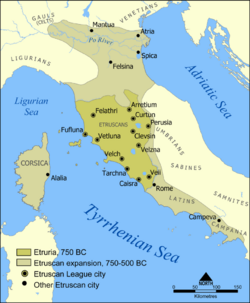
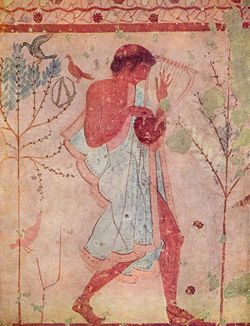
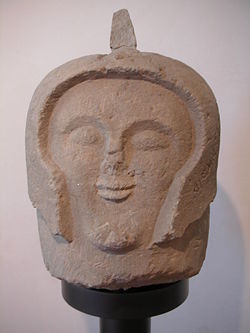
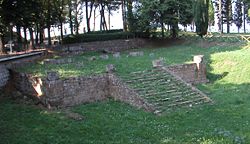
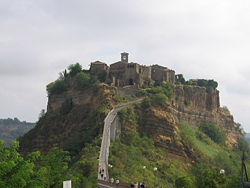
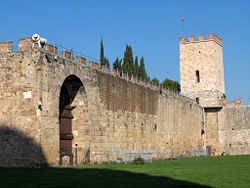
 KSF
KSF